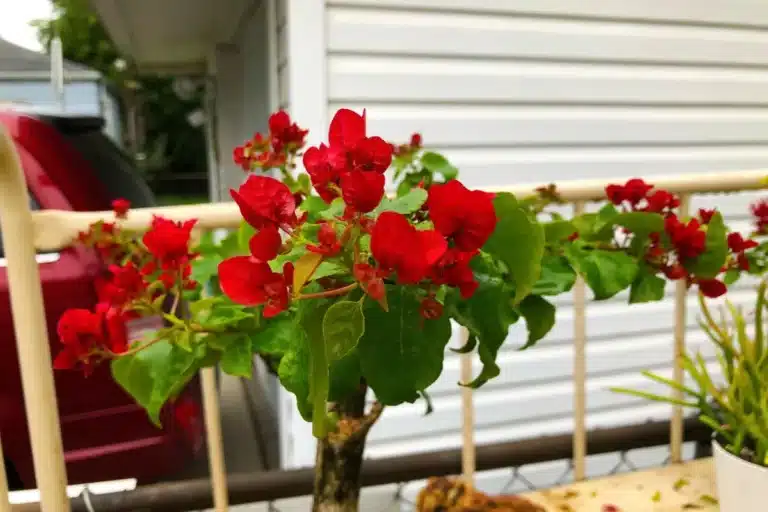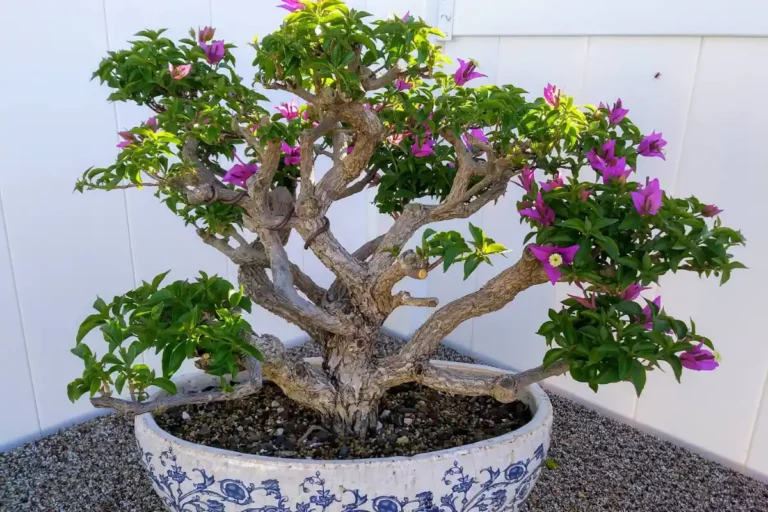The 5 Causes of Bougainvillea Leaf Curl and Wrinkling
Leaf problems are expected in bougainvillea if the plant isn’t getting proper care or is trying to survive extreme climates. Curling leaves particularly point to sunlight and temperature problems.
In short, the plant is stressed, and the problem should be fixed soon.
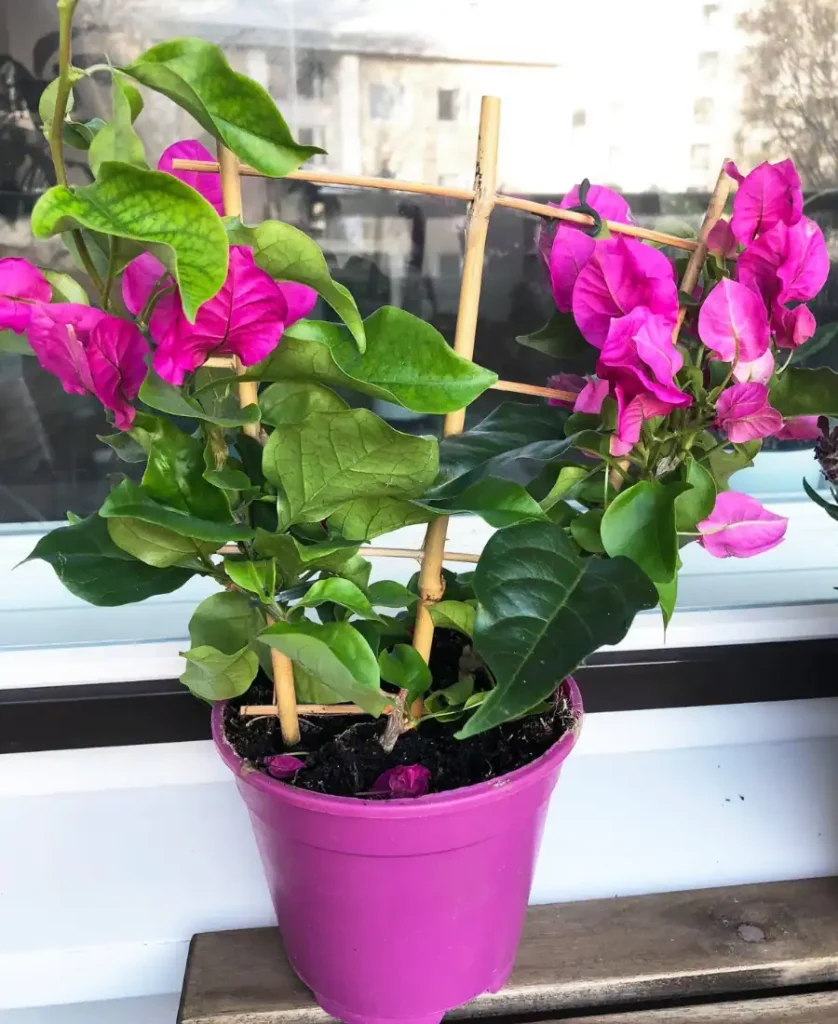
Contents:
What causes bougainvillea leaf curl?
The main reasons for bougainvillea leaf curl are pests, water stress, diseases, low light intensity, and scorching heat. Flushing the leaves with a jet of water and treating them with neem oil can get rid of pests, but if the issue is insufficient light, move the plant where it will receive full sun every day.
More on caring for bougainvillea here.
Let’s troubleshoot the causes of leaf curl further.
1. Pest infestation
Bougainvillea can grow bushy with huge underbrush that pests as big as rats love. But rats aren’t the cause of wrinkling leaves; aphids, mealybugs, and soft scales are the most common culprits when there’s leaf damage.
Aphids
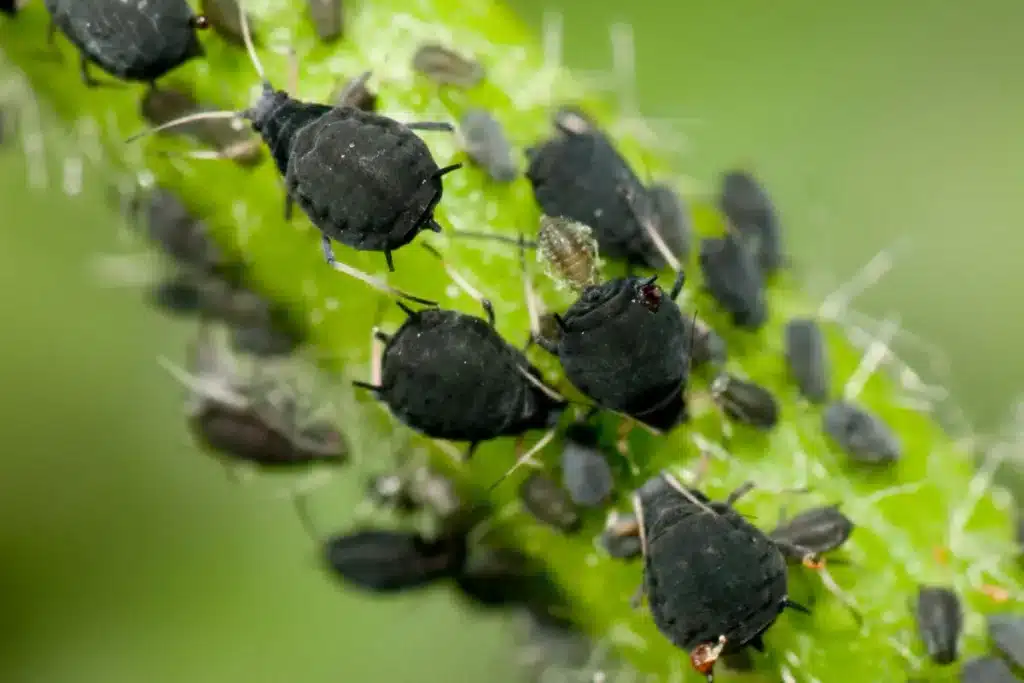
Aphids are small, sap-sucking insects that can damage bougainvillea plants. They can cause leaves to curl, wilt, and drop, and they can also spread diseases.
They exist in different colors, including yellow, black, brown, green, and pink.[1] The brown and green-bodied aphids are the most widespread species found on bougainvillea.
They invade and suck sap from foliage and release toxic substances on them. Furthermore, they excrete honeydew (a sugary substance) on the leaves, branches, and stems. Honeydew droplets encourage powdery mold to grow, which blocks sunlight from reaching the leaves. The plant, therefore, makes less food, damaging its health.
Severe aphid infestation on bougainvillea leads to curling and yellowing or leaves; in some cases, the damaged leaves drop prematurely.
Solution: Aphids are a common problem in early spring when their predators are not yet abundant. You can dislodge them from plants with a hose of water or kill them with a spray of insecticidal soap. I recommend acting quickly, as the longer you wait, the more aphids will multiply, and the harder they will be to control.
Soft Scales
Soft scales are small, brown, or tan insects that attach themselves to bougainvillea branches and suck the plant’s sap. They can cause the leaves to curl, wilt, and drop.
They like to hide on the lower surfaces of leaves and stems. Like aphids, soft scales suck sap from the foliage and release honeydew when feeding. The honeydew encourages powdery mold fungi to grow.
Uncontrolled soft scales infestation can cause premature plant death.
Solution: You can remove scale insects manually if the infestation is light, but I recommend applying a spray of insecticidal soap, neem oil, or horticultural oil. If these don’t work, go for a systemic insecticide like Imidacloprid.[2]
I use Bonide (BND951), a systemic solution when dealing with widespread infestations of scale, aphids, whiteflies, and other pests on overgrown bougainvillea and other plants. It works well for me and kills some of the pests within 60 seconds.
Mealybugs
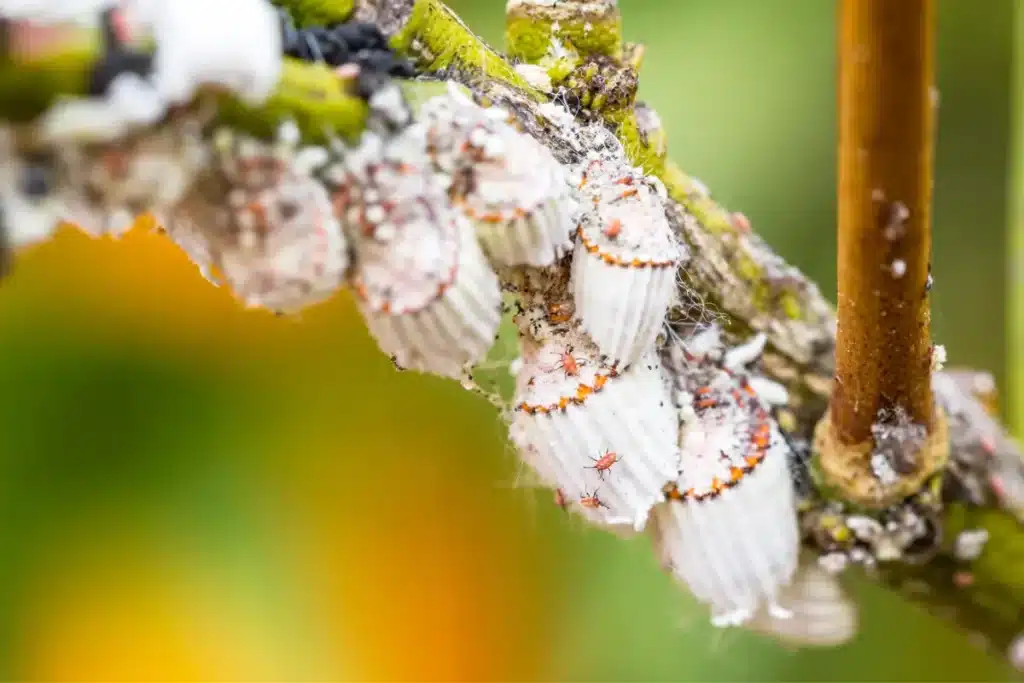
Mealybugs are small, oval sap-sucking insects that infest many different plants, including bougainvillea. They appear as white, cottony masses on the stems and leaves of the plant. Mealybugs can weaken the plant and cause the leaves to curl.
They are less than an inch long and look like scales. These insect pests produce a waxy substance immediately after they start feeding.
Mealybugs hide on the lower sides of the foliage, while some species move to the roots. Once settled, they suck sap and excrete honeydew, which promotes the growth of powdery mold fungi.
Solution: I recommend using natural predators such as ladybugs to control mealybug populations on your bougainvillea. If that’s not an option for you, simply use rubbing alcohol. Soak a cotton ball or Q-tip in rubbing alcohol and gently clean all affected areas of your plant. Mealybugs like to hide, so inspect your plant carefully to ensure you have cleaned all the affected areas.
General pest prevention and treatment
Many other pests can also be a problem. For example, spider mite colonies can appear dense and seriously damaging to plants. You want to ensure you have the correct solution for them.
Hose the plant and wipe the leaves with neem oil.
Hosing infested plant parts and wiping them with neem oil solution is a suitable method to remove pests on bougainvillea. If you have insects on the leaves and stems, tap them with your fingers to remove them. You can also hose down the plant with water to remove the pests.
Next, wipe the leaves with a cloth soaked in neem or horticultural oil. Alternatively, dip the fabric in insecticidal soap or rubbing alcohol before rubbing.
Wipe the plant parts for the next few days until the plant remains pest-free.
Treat bougainvillea with insecticides containing pyrethrin, deltamethrin, or cyfluthrin for heavy pest infestation. Follow the instructions while applying all necessary safety measures.
2. Diseases
Leaf spot and root rot are the two most common diseases that cause curled bougainvillea leaves.
Here’s how they affect your plant.
Leaf spot
Leaf spot is a bacterial infection caused by members of the genus Xanthomonas. Poor watering techniques, high temperatures, and heavy rainfall provide ideal conditions for this bacteria.
Overhead irrigation and splashing water on the leaves of bougainvillea leaves provide the best media for the transfer and spread of the bacteria.
At early infestation stages, a leaf spot diseased bougainvillea shows reddish spots between the leaf veins and surfaces. Later, the leaves curl, wither, and become distorted.
Treatment:
- Remove and destroy infected leaves. This will help to stop the spread of the bacteria.
- Water your plants at the base, not overhead. This will help to prevent the leaves from getting wet, which can make the bacteria more likely to spread.
- Apply a copper-based fungicide. Copper-based fungicides can help to kill the bacteria and prevent the disease from spreading.
Root rot
Root rot is a fungal infection caused by Rhizoctonia and other fungi species. Overly moist soils and warm temperatures provide favorable conditions that breed fungi on the plant’s soil, encouraging them to cause and spread root rot disease.
The Rhizoctonia fungi appear reddish-brown on the stem and root surfaces.
These fungi damage and weaken the root system, preventing them from absorbing water and mineral salts.
A bougainvillea suffering from root rot disease has yellowed and curled leaves in the early infection period. The roots also appear black or brown, smelly, and mushy. Severe root rot causes stunted growth and kills the plant if not treated.
Treatment
Avoid overwatering, correct drainage problems, and repot the plant.
Root rot disease results from soggy soils caused by overwatering and poorly draining soils.
To treat potted bougainvillea with root rot disease, stop watering the plant for the next week to allow the soil dry. Add peat moss or compost to improve aeration and drainage if the soil has poor drainage. Also, check the pot to ensure it has enough drainage holes.
Treat moderately root-rot-infected bougainvillea by repotting with fresh, well-draining soil in a new container.
Here’s how to repot your plant
- Tilt the pot and let it lie on its side
- Grab the lower part of the stem near the soil surface and gently pull the plant from the soil.
- Shake the soil around the rootball and check the roots
- Snip any black or brown damaged roots which appear mushy and smell foul
- Rinse the remaining good roots with a hose and air-dry them
- Prepare a new pot with enough drainage holes and fresh, well-draining soil mix
- Add the mix into the container and dip your bougainvillea into it
- Add more soil, ensuring it holds the stem firmly in the pot
- Water the plant lightly and place it in full sun.
3. Insufficient light
Bougainvilleas are tropical and subtropical plants native to South America. They thrive in locations with direct, full sunlight of at least six hours of daily exposure.
Growing this plant in partial sunlight or full shade results in curled leaves.
When there’s little or no light, the plant cannot make its own food adequately and thus becomes stressed. The leaves turn yellow and curl.
The fix:
Move your plant to a site with full sun.
To treat curled leaves from low light intensity, move potted bougainvillea to a location with full sun. Bring the plant near a window where it can get enough light.
Trim overhanging branches and leaves nearby to allow sunlight to reach the bougainvillea growing in the landscape.
4. Scorching heat
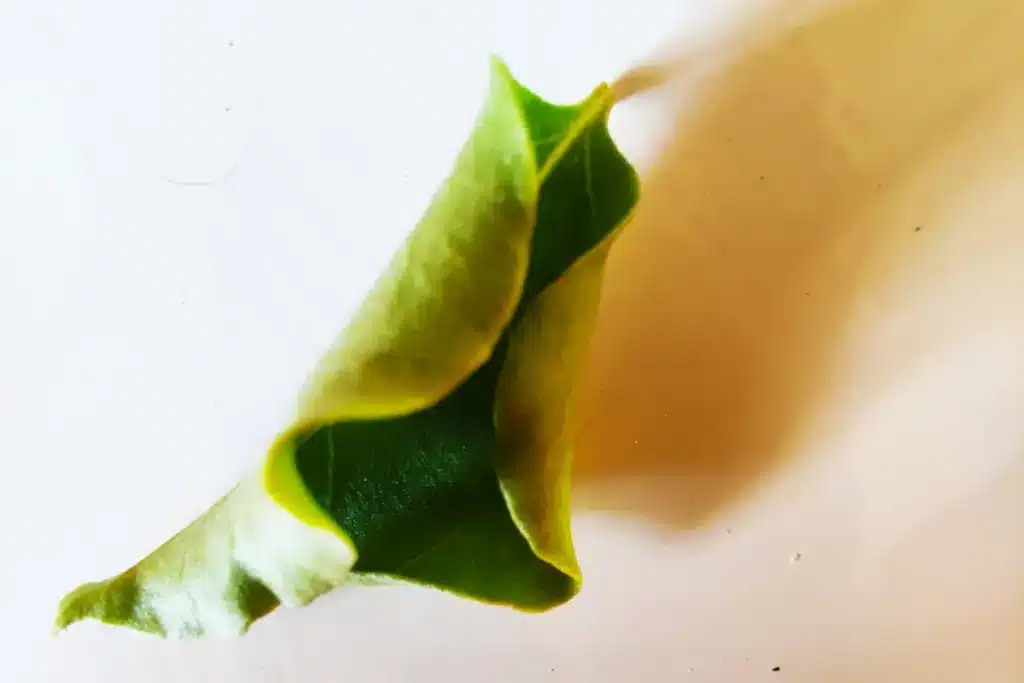
When plants are exposed to extreme heat, they can experience water loss through their leaves. This can cause the leaves to curl up in an attempt to conserve moisture.
Other symptoms of heat stress in bougainvillea include wilting, yellowing leaves, and dropping leaves.
Best fix
Ensure that the plant is getting enough water. Water deeply and regularly, especially during hot, dry weather.
If you’re growing a potted bougainvillea, move it to a location protected from the sun’s direct rays.
If the plant is already showing signs of heat stress, you can try misting the leaves with water to help them cool down. This will work for bougainvillea planted in pots but may not be very practical for larger outdoor plants.
5. High temperatures
Related to scorching heat, high temperatures can cause leaf curl in bougainvillea. When the temperature is too high, the plant’s leaves will curl up to conserve moisture.
This is a natural defense mechanism that helps the plant prevent water loss. You may also notice leaf loss, yellowing of foliage, wrinkled leaves, and wilting.
If you live in an area with hot summers, I advise watering your bougainvillea regularly, especially during hot, dry weather. Also, try to provide your plant with some shade during the hottest part of the day.
Move the stressed plant to a cooler location or watering it more frequently.
Trim the curled leaves
To treat a bougainvillea suffering from leaf spot, start by pruning damaged leaves with patches and irregular shapes. Dispose of them in a safe place.
Avoid adding the pruned leaves to your compost pit to curb bacteria spreading.
Pruning encourages the plant to concentrate its energy on growing new, healthy leaves without wasting it on reviving the damaged ones.
Dispose of severely infected plants, and remove any remains.
Practice proper watering techniques to ensure the leaf spot-causing bacteria doesn’t live on your plant’s soil. Avoid overhead irrigation since it splashes water droplets on the leaves, providing a transport medium to spread bacteria on the plant.
Instead, water your bougainvillea using a sprinkle, and direct the spout on the soil. The most favorable time to water is mid-morning to allow excess water to evaporate and the leaves to dry fast.
Conclusion
The summary table below summarizes the causes and fixes of leaf curl in bougainvillea.
| Cause | Fix |
| Pests | Hose them with water and wipe the leaves with neem oil |
| Diseases | Prune damaged leaves and avoid splashing water on the leaves. |
| Low light intensity | Move the plant to a location with full sun |


